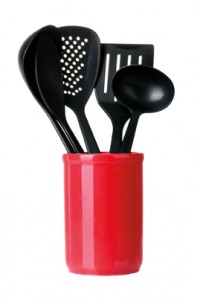Cooking Terminology: Back to Basics
Posted on May 28, 2013 by bob in GPlenty
 Did you know a ‘dash’ as called for in a recipe is considered less than 1/8 teaspoon? Cooking Basics from the Alabama Cooperative Extension Service is a great review for kitchen wizards and a wonderful learning tool for new cooks. We thank ACES for their generosity in letting Prime offer it to our readers. You can find more information on their website, www.aces.edu/.
Did you know a ‘dash’ as called for in a recipe is considered less than 1/8 teaspoon? Cooking Basics from the Alabama Cooperative Extension Service is a great review for kitchen wizards and a wonderful learning tool for new cooks. We thank ACES for their generosity in letting Prime offer it to our readers. You can find more information on their website, www.aces.edu/.
Bake/Roast — Cook food uncovered in an oven or similar appliance.
Beat — Make mixture smooth with rapid, regular motion using a wire whisk, spoon, hand beater, or mixer. When using a spoon, lift the mixture up and over with each stroke.
Blend — Mix two or more ingredients thoroughly.
Boil — Heat a liquid until bubbles break on the surface or cook in boiling water.
Braise — Slowly cook meat or poultry in a small amount of liquid in a covered pot.
Broil — Use direct heat to cook.
Brown — Cook quickly until surface of food is brown.
Chop — Cut food into small pieces.
Coat — Cover entire surface with a mixture such as flour or bread crumbs.
Core — Using a sharp knife, remove the core and seeds of fruit.
Cream — Stir one or more foods until they are soft.
Crisp-tender — The “doneness” of vegetables when they crisp in texture.
Crush — Use a garlic press or a blunt object to smash foods such as garlic until the fibers separate.
Cube — Cut food into small, 1/2-inch cubes.
Dash — Less than 1/8 teaspoon.
Dice — Cut into small, square-shaped pieces.
Drain — Put food and liquid into a strainer or colander, or pour liquid out of a pot by keeping the lid slightly away from the edge of the pan and pouring away from you.
Flute — Pinch the edges of dough such as on pie crust.
Fold — Mix by turning over and over.
Fork-tender — The “doneness” of a food when a fork can easily penetrate the food.
Fry — Pan fry: Cook in frying pan over medium heat with small amount of oil.
Deep fry: Cook in hot oil deep enough for food to float.
Grate — Rub food on a grater or chop in blender or food processor to produce fine, medium, or coarse particles.
Grease — Cover or lubricate with oil to keep food from sticking.
Knead — Work dough by folding and stretching with heel of hand.
Marinate — Allow food to soak in liquid to increase flavor and tenderness.
Mince — Cut or chop food into small pieces.
Mix — Combine ingredients using a fork or spoon.
Oil — Apply a thin layer of vegetable oil on a dish or pan. Can substitute vegetable oil spray.
Peel — Remove outer covering of foods by trimming away with a knife or vegetable peeler.
Preheat — Heat oven to desired temperature before putting food in to bake.
Poach — Cook food over low heat in a small amount of hot, simmering liquid.
Saute — Cook in a small amount of oil or water.
Scald — Heat milk until bubbles appear. Bubbles should not be “breaking” on the surface.
Shred — Rub foods against a grater to divide into small pieces.
Sift — Remove lumps or lighten the dry ingredients by putting them through a strainer or a sifter.
Simmer — Cook at a temperature just below the boiling point. Bubbles form slowly but do not reach the surface.
Slice — Cut food into thin pieces.
Steam — Cook over boiling water.
Stew — Cook food over low heat in a large amount of simmering liquid.
Stir-fry — Quickly frying vegetables to a crisp-tender state while constantly stirring.
Stock — Water in which vegetables or meat has been cooked; should be stored in the refrigerator.
Thaw — Slowly change from a frozen state to a liquid state.
Toss — Mix foods lightly with a lifting motion, using forks or spoons.









